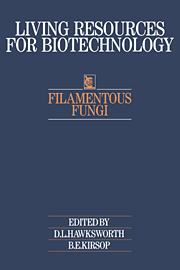Book contents
- Frontmatter
- Contents
- Contributors
- Series introduction
- Preface
- Acknowledgements
- 1 Resource centres
- 2 Information resources
- 3 Administration and safety
- 4 Culture and preservation
- 5 Identification
- 6 Patent protection for biotechnological inventions
- 7 Culture collection services
- 8 Organisation of resource centres
- Appendix: Media
- References
- Index
Preface
Published online by Cambridge University Press: 04 August 2010
- Frontmatter
- Contents
- Contributors
- Series introduction
- Preface
- Acknowledgements
- 1 Resource centres
- 2 Information resources
- 3 Administration and safety
- 4 Culture and preservation
- 5 Identification
- 6 Patent protection for biotechnological inventions
- 7 Culture collection services
- 8 Organisation of resource centres
- Appendix: Media
- References
- Index
Summary
The filamentous fungi represent the group of microorganisms with the largest number of species, showing an immense variety not only in morphology but also in physiological and biochemical attributes. About 63 700 species (excluding yeasts) are currently known, but around 1500 are described as new to science each year, and the number in nature may well exceed 250 000. Over 3000 secondary metabolites have already been characterised, but actual numbers are far in excess of this and the biological activities of most remain to be determined. The biotechnological importance of the filamentous fungi is, therefore, of considerable significance, and the potential of this vast resource is only now starting to be appreciated by biotechnologists. Fortunately they have at their disposal over 170 000 strains maintained in culture collections throughout the world.
This book provides an introduction to these resources and describes how information can be obtained on what is available, how filamentous fungi can be preserved and identified, how collections operate, and the additional support services available from them.
In preparing this volume, I have been fortunate in securing the assistance of colleagues from different parts of the world who are experienced with the work of culture collections, as curators or users, as well as from the individual collections themselves. Without their help the international overview this text aims to provide could not have been presented.
- Type
- Chapter
- Information
- Filamentous Fungi , pp. xiPublisher: Cambridge University PressPrint publication year: 1988



